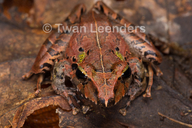|
Craugastor crassidigitus (Taylor, 1952)
Isla Bonita Robber Frog Subgenus: Craugastor | family: Craugastoridae genus: Craugastor |
 © 2017 Twan Leenders (1 of 17) |
|
|
|
Description Description: The head is relatively narrow, measuring at 35.5-41.0% of the SVL. The snout is subacuminate and moderate in length. The tympanum is distinct and measures at one-half to two-thirds the length of the eye in males and two-fifths to three-fifths the eye length in females. The dorsal skin is shagreened with warts on the scapular region. Fingers I and II have round discs and fingers III and IV are truncated. Toes are moderately webbed with lateral fringes on the unwebbed portions. Males have a subgular vocal sac and vocal slits, but are usually not visible externally. Males also have nuptial pads on their thumbs, which are non-spinous (Lynch and Myers 1983) . Coloration and Coloration Variation: Dorsal coloring varies widely in C. crassidigitus. Costa Rican populations are lavender to reddish olive brown. Panamanian populations can be grey, grayish brown, light or dark brown, pinkish brown, orangish brown, and reddish brown. The venter is typically white or light yellow. The limbs are pale green or yellow underneath, and sometimes even orange. Individuals may have thighs, which are suffused, or flecked, with orange and red. Throat coloration is highly variable, ranging from white to black. The lower part of the iris is pale grey, while the upper iris can be grey, bronze, brown or red. C. crassidigitus has three main patterns: (1) uniform background color with dark markings on the back, typically an hourglass, scapular butterfly, or a W, and a bar or butterfly between the eyes (2) pale, unmarked coloration from snout to end of body, with dark lines along the edge of the dorsum, and (3) similar to type 2, but with a pale median stripe (Lynch and Myers 1983). Distribution and Habitat Country distribution from AmphibiaWeb's database: Colombia, Costa Rica, Panama
Life History, Abundance, Activity, and Special Behaviors Males do call, usually from twigs or other perches near the ground. Calls are rare during the dry season, even though the frogs are active. There are two known calls: a birdlike chirp and a chuck chirp. The birdlike chirp is approximately 0.10-0.12 s long, measured at 1400-4500 Hz. These calls are evenly pulsed, but there is some variation among males. The chuck chirp is 0.02-0.13 s long, and the short notes sound like clicks. Chuck chirps are non-melodious, start out slow and speed up at the end. It is unknown if these calls change when encountering intruders or potential mates. Females are also thought to give calls when in distress (Lynch and Myers 1983). C. crassidigitus has direct development (Solis et al. 2008). Trends and Threats Relation to Humans Comments
References
Crawford, A. J., and Smith, E. N. (2005). ''Cenozoic biogeography and evolution in direct-developing frogs of Central America (Leptodactylidae: Eleutherodactylus) as inferred from a phylogenetic analysis of nuclear and mitochondrial genes.'' Molecular Phylogenetics and Evolution, 35, 536-555. Lynch, J. D., and Myers, C. W. (1983). ''Frogs of the fitzingeri group of Eleutherodactylus in eastern Panama and Chocoan South America (Leptodactylidae).'' Bulletin of the American Museum of Natural History, 175(5), 484-568. Solís, F., Ibáñez, R., Chaves, G., Savage, J., Jaramillo, C., Fuenmayor, Q., Lynch, J., and Bolaños, F. (2008). Craugastor crassidigitus. In: IUCN 2010. IUCN Red List of Threatened Species. Version 2010.4. www.iucnredlist.org. Downloaded on 29 April 2011. Originally submitted by: Angela Flemming (first posted 2009-11-02) Edited by: Kandys Kim, Michelle S. Koo (2023-03-15) Species Account Citation: AmphibiaWeb 2023 Craugastor crassidigitus: Isla Bonita Robber Frog <https://amphibiaweb.org/species/2863> University of California, Berkeley, CA, USA. Accessed Jun 4, 2025.
Feedback or comments about this page.
Citation: AmphibiaWeb. 2025. <https://amphibiaweb.org> University of California, Berkeley, CA, USA. Accessed 4 Jun 2025. AmphibiaWeb's policy on data use. |




 Map of Life
Map of Life